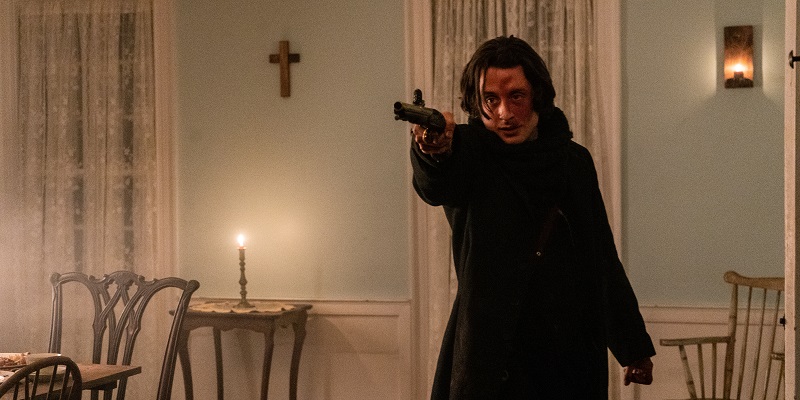
Review by
Eric Hillis
Directed by: Edoardo Vitaletti
Starring: Stefanie Scott, Isabelle Fuhrman, Rory Culkin, Judith
Anna Roberts, PJ Sosko

An opening quote from John Calvin sets the austere tone for
writer/director Edoardo Vitaletti's folk-horror
The Last Thing Mary Saw. It's New York in 1843, and it seems the puritanical instincts of the
pilgrims who landed not too far away a couple of centuries earlier still
linger in this neck of the woods.

Whatever the last thing Mary (Stefanie Scott) saw actually was,
it seems to have left her mentally and physically scarred. We meet her
as she's interrogated by local constables who accuse her of some
unspoken crime. A blindfold covers a pair of bloodied eyes, dried
crimson streaks on her cheeks giving her the appearance of a human
Rorschach test.
Through flashbacks we learn of Mary's affair with her family's maid (Isabelle Fuhrman, so great in the recent
The Novice
but given little to do here). Her family reacts with puritanical
outrage, turning to their sinister matriarch (Judith Roberts),
who devises a series of physical and mental punishments for Mary and her
lover. What the family doesn't realise is that Mary and the maid are
conspiring against them with the aid of a mysterious book of
wood-carvings and the assistance of the estate's guard (PJ Sosko).

The Last Thing Mary Saw is torn between folk-horror and
period romance, but fans of either sub-genre may be left feeling a
little dissatisfied. The horror elements are so few and far between that
it's a jolt when a supernatural element pops up in the climax. The
lesbian affair is so thinly sketched that it's hard to believe these two
young women would risk so much for what seems like a passionless
relationship.
The period recreation never quite convinces. There's something a little
too modern about the faces of the cast, a lack of a lived-in quality in
both the people and the spaces they inhabit. Keegan DeWitt's
cacophonous score is interchangeable with a dozen other folk-horror
adjacent movies of recent years, all ominously plucked strings and
breezy woodwinds. The slowburn atmosphere too often comes off as
misjudged pacing for a story that could have easily been told as a 30
minute segment of an anthology show.

The film is ultimately enlivened by a late cameo by
Rory Culkin as a mysterious, facially-scarred figure who arrives
with seemingly sinister intentions. The plans of both the matriarch and
the young lovers are scuppered by the arrival of a figure we surmise
might be the devil himself. Culkin doesn't seem an obvious choice to
portray Old Nick, but there's something undeniably creepy about his
soft-spoken delivery and unblinking eyes here. His presence gives the by
then running on fumes narrative the jolt it badly needs.


